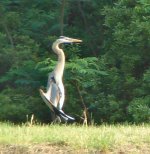OldFolks
OldFolksB&B
Heron Sunning itself
I've never seen this before, but then again, I lead a very sheltered life indoors.:-O
Is it a common occurrence?
I've never seen this before, but then again, I lead a very sheltered life indoors.:-O
Is it a common occurrence?




